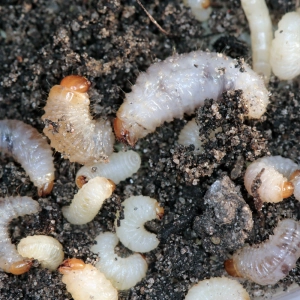Vine weevils are parthenogenetic (reproduce without mating). This makes for a successful pest because whilst they lack working wings and cannot fly from plant to plant, only one weevil is required to start an infestation.
Adult vine weevils are incredibly difficult to spot – especially during the day. They’re nocturnal and will hide in leaf debris, under mulch or under your plant pots during the day.
Like many garden pests, the real damage is done by the pest larvae in the soil, and vine weevil larvae are no different.
Unexplained wilting (particularly in container plants) can be an early indicator of their presence, whereas leaf ‘notching’ on the edges of leaves indicates eating damage by the adult weevil. Root damage by the larvae has the potential to kill entire plants.
What you need to know about adult vine weevils
These creatures grow to around 11mm in length and are grey /back in colour with clumps of delicate orange hairs on their backs giving them a spotty look.
They are not particularly fussy eaters and will consume the leaf matter of more than 200 plant types through spring and summer. They are fond of evergreens so notching damage will still be seen on these plants right through winter.
Adult weevils can emerge from mid-April (depending on temperatures) but are more likely to be seen from May onwards. They will remain active on their chosen plants in temperatures above 6°C, making them a resilient visitor to British gardens in spring.
They will feed for around a month and then start laying eggs – usually from June onwards. As they feed, they create notches along the edges of leaves which although unlikely to impact the overall vigour of your plants, can look unsightly.
Each adult weevil can lay up to 300 eggs at a time (or more if laying in greenhouses or polytunnels), and just one adult weevil can lay around 1600 eggs in its lifetime.
Given these volumes, it’s perhaps easy to see why breaking their cycle is crucial to prevent uncontrollably large infestations.
Which biopesticide should be used to control vine weevils
The natural predators of vine weevil larvae are nematodes, specifically the species Steinernema kraussei and Heterorhabditis bacteriophora. Either species can be applied to containers, open soil, beds, borders, and around trees and shrubs.
Both these species of nematode are microscopic worms that actively seek out the vine weevil grubs, feeding and multiplying inside them, then infecting them with a bacterium.
Once infected, the vine weevil larvae will stop feeding and die. The nematode will then leave the dead vine weevil and go on to seek out more, repeating the cycle.
Your choice of nematode species will depend on the soil temperature as both species are highly effective at controlling the larval stages of black vine weevil and other weevil species.
Low temperature control
Low temperature control can be used when the soil temperature is between 5°C and 30°C, making them ideal for use earlier in the growing season. This product contains the beneficial parasitic nematode Steinernema kraussei.
Higher temperature control
High temperature control should be used when the soil temperature is between 12°C and 30°C, making them ideal for later in the growing season. This product contains the beneficial parasitic nematode Heterorhabditis bacteriophora.
How to use nematodes as a biopesticide
Nematodes are particularly effective in damp, wet weather, so try and choose a humid or wet day to apply the nematodes.
They are UV-sensitive so it is best to avoid applying them on a bright sunny day as they will not survive in these conditions. The best humidity levels are often found first thing in the morning or late afternoon.
You apply nematodes by dissolving the pack contents in a bucket of water to create a stock solution.
You then further dilute some of this stock solution in more water in a watering can. Specific dilution and application rates are shown on our product page and depend on what size pack coverage you select.
Once you have the stock correctly diluted, you simply pour the solution directly onto the soil around the affected plants.
Nematodes are harmless to other wildlife, earthworms, bees and birds, and can be used successfully in an organic gardening programme.
This choice of biopesticide will provide long-lasting control of vine weevils and can be used alongside other biological controls.




